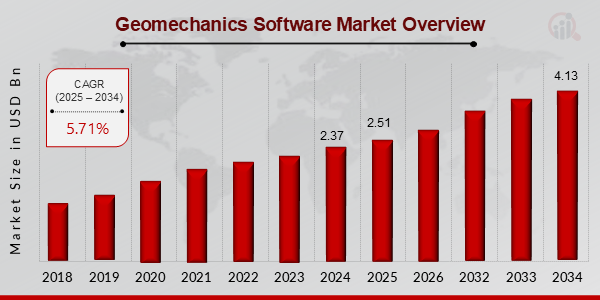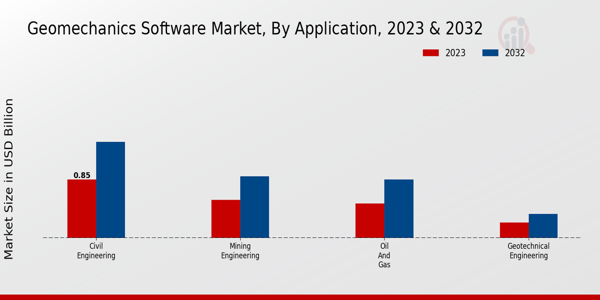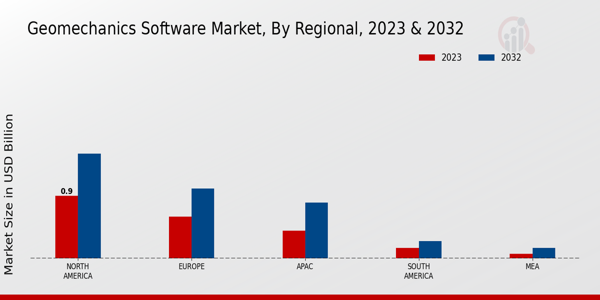Geomechanics Software Market Overview
Geomechanics Software Market is projected to grow from USD 2.51 Billion in 2025 to USD 4.13 Billion by 2034, exhibiting a compound annual growth rate (CAGR) of 5.71% during the forecast period (2025 - 2034). Additionally, the market size for Geomechanics Software Market was valued at USD 2.37 billion in 2024.
Key Geomechanics Software Market Trends Highlighted
The Geomechanics Software Market is going through various changes because of internal and external market forces. For instance, the growing need to manage operations including oil and gas management, mining, and construction has given rise to the usage of geomechanics software. This includes modeling and simulation for predicting the behavior of geological systems over time and other such conditions which require sophisticated software solutions. As a result of the increasing importance of safety and environmental protection legislation, organizations are required to deploy such technologies in order to manage risks associated with geotechnical activities.
However, the geomechanics software industry comes with numerous restrictions that need to be lifted. Because of the shift towards digital platforms in any industry, geomechanics tools can be combined with other technological advancements like artificial intelligence, machine learning or data analytics tools. Such developments can enhance businesses by improving customers’ decision-making and optimizing their operations. In addition, growing markets in the third world countries give an opportunity for software vendors to begin business and satisfy local needs especially in infrastructure and renewable energy. Both investment and market trends in the recent past appear to indicate a pivot towards cloud based geomechanics tools.
The change brings advantages such as increased accessibility, enhanced scalability, and reduced cost which allows organizations to work together easily regardless of distance or timezone. There is also a growing trend towards the need for real time data along with the trend of incorporating business users as more clients request insights that will enable them to act instead of having to deal with the consequences of the issue. All in all, the Geomechanics Software Market is changing its face, creating problems, but also big chances for those involved within this ever changing market.
Figure 1 Geomechanics Software Market Overview (2025-2034)

Source: Primary Research, Secondary Research, MRFR Database and Analyst Review
Geomechanics Software Market Drivers
Increasing Demand for Enhanced Resource Exploration and Management
The Geomechanics Software Market Industry is experiencing significant growth driven by the increasing demand for enhanced resource exploration and management techniques. As companies across various sectors, such as oil and gas, mining, and civil engineering, focus on optimizing resource extraction efficiency and minimizing environmental impact, innovative software solutions have become essential. The rising complexity of geomechanical environments requires advanced modeling and simulation tools that can predict behavior under various conditions, thus improving project success rates.
This increasing reliance on advanced geomechanical software not only ensures better safety and compliance with regulatory standards but also enhances overall project profitability. Moreover, the growing emphasis on sustainability has prompted firms to adopt geomechanics software to better understand subsurface interactions, manage resources responsibly, and optimize drilling and extraction processes. As the global demand for raw materials continues to rise, coupled with the push towards sustainable practices, the value placed on effective geomechanics software will undoubtedly expand, propelling the overall market forward significantly in the coming years.
Technological Advancements in Software Solutions
The Geomechanics Software Market Industry is significantly influenced by rapid technological advancements in software solutions. Enhanced computational capabilities, data analytics, and artificial intelligence are reshaping the landscape of geomechanical modeling, simulation, and analysis. These technologies enable more accurate predictions of geological behavior and help identify potential risks associated with projects. As software continues to evolve, user-friendly interfaces and improved data integration have become prevalent, allowing engineers and geologists to work more efficiently and effectively, thus driving demand for state-of-the-art geomechanics solutions.
Growing Investments in Infrastructure Development
Another crucial driver of the Geomechanics Software Market Industry is the growing investments in infrastructure development across the globe. Nations are increasingly allocating budgets for infrastructure projects such as highways, bridges, and tunnels, which require comprehensive geomechanical assessments to ensure safety and stability. This surge in infrastructure spending is anticipated to fuel the demand for geomechanics software as companies seek robust engineering solutions to inform their designs and project management processes.As more projects emerge, the necessity for effective geomechanics tools will continue to rise, supporting market growth.
Geomechanics Software Market Segment Insights
Geomechanics Software Market Application Insights
The Geomechanics Software Market, particularly in the Application segment, presented a valuation of 2.12 USD Billion in 2023, with projections to reach 3.5 USD Billion by 2032, showcasing significant growth potential. Among the various applications, the Civil Engineering portion is notable, with a market valuation of 0.85 USD Billion in 2023, expected to expand to 1.4 USD Billion by 2032, reflecting its crucial role in urban development and infrastructure projects. Mining Engineering also holds a substantial portion of the market, valued at 0.55 USD Billion in 2023 and anticipated to grow to 0.9 USD Billion by 2032, indicative of the increasing demand for advanced methodologies in resource extraction and site management.
The Oil and Gas sector, while smaller, is still significant, with a valuation of 0.5 USD Billion in 2023 growing to 0.85 USD Billion by 2032, driven by exploration and production activities that increasingly rely on accurate geomechanical modeling to minimize environmental impacts and enhance operational efficiency. Lastly, the Geotechnical Engineering application is valued at 0.22 USD Billion in 2023 and is projected to reach 0.35 USD Billion by 2032, as organizations focus on safer and more sustainable construction practices.
The majority of the market growth stems from the increasing need for geological analysis tools across various engineering disciplines, driven by infrastructure demands, energy sector advancements, and the ongoing push towards sustainable practices in construction and resource extraction.
Growth drivers include technological advancements in software capabilities, increased investment in infrastructure and energy projects, and heightened awareness of geological risks in engineering projects. However, challenges such as the complexity of software adoption and the need for skilled personnel to operate these tools could impact market progression. Nonetheless, opportunities abound as industries look to leverage sophisticated geomechanics software to enhance project outcomes and mitigate risks associated with ground stability and resource management.The Geomechanics Software Market industry is characterized by a trend towards integration of data analytics and machine learning in geomechanical modeling, reflecting an industry shift towards more sophisticated and predictive approaches that can address evolving challenges. Overall, the segmentation of the Geomechanics Software Market into various applications not only illustrates diverse usage but also underscores the growing recognition of geomechanics as an essential element in modern engineering practices.
Figure 2 Geomechanics Software Market By Application (2023-2032)

Source: Primary Research, Secondary Research, MRFR Database and Analyst Review
Geomechanics Software Market Deployment Type Insights
The Geomechanics Software Market, valued at 2.12 USD Billion in 2023, shows a significant focus on the Deployment Type segment, which includes On-Premises and Cloud-Based solutions. The demand for deployment options is largely driven by organizations seeking flexibility and control over their geomechanical processes. On-Premises solutions typically appeal to enterprises requiring stringent data security and compliance with local regulations, offering them greater control of their data management. On the other hand, Cloud-Based solutions are gaining traction due to their scalability, ease of access, and reduced initial investment costs, making them a preferred choice for smaller companies or those with fluctuating resource needs.
The market trends reflect a steady shift towards Cloud-Based implementations, driven by increasing digitalization and the need for real-time data access. However, some challenges persist, including concerns over data security in the cloud and the necessity for reliable internet connectivity. Despite these challenges, the Geomechanics Software Market is set for growth, with both deployment types presenting substantial opportunities for innovation and expansion, aligning well with global trends towards flexibility and efficiency in mining and construction industries.
Geomechanics Software Market Software Type Insights
In 2023, the Geomechanics Software Market is valued at approximately 2.12 USD Billion, with strong growth anticipated through to 2032. The market segmentation of Software Type includes key components such as Surface Modeling, Subsurface Modeling, Geotechnical Analysis, and Monitoring and Inspection. Surface Modeling plays a critical role, as it provides essential visual representations that guide project planning and decision-making. Similarly, Subsurface Modeling is significant for its ability to analyze sub-surface conditions, which are crucial for effective resource extraction and risk management.
Geotechnical Analysis supports the market by facilitating the assessment of ground behaviors, allowing for safer construction practices. Monitoring and Inspection ensure compliance and safety by continuously observing project impacts. The growth of the Geomechanics Software Market is driven by increasing demand in industries such as mining and oil gas, enabling better data management and collaboration. However, challenges such as integration across platforms and the need for skilled professionals can hinder market development. Overall, the market growth reflects an expansion of techniques and tools aimed at improving project efficiency and safety in geotechnical engineering.
Geomechanics Software Market End Use Insights
The Geomechanics Software Market is projected to be valued at 2.12 billion USD in 2023, reflecting a growing focus on precision in managing subsurface interactions. Within the End Use segment, key areas such as Construction, Energy, Environmental Engineering, and Infrastructure play pivotal roles in driving market growth. The Construction sector benefits significantly from geomechanics software, aiding in the safe planning of foundations and earthwork projects, ultimately reducing risks associated with ground stability. Energy, on the other hand, relies on advanced geomechanics tools for the exploration and extraction of resources in fields like oil and gas, a practice essential for ensuring operational efficiency.
The Environmental Engineering sector utilizes geomechanics software for site assessments and environmental impact analysis, ensuring sustainable practices are upheld. Additionally, the Infrastructure sector emphasizes the importance of geomechanics in evaluating and maintaining the integrity of existing structures, leading to enhanced safety and cost-effectiveness. As the market evolves, trends such as increasing investments in infrastructure development and a focus on sustainable energy solutions provide significant opportunities for innovation and market penetration within these various applications, highlighting the vital importance of the Geomechanics Software Market.Market growth is further supported by the increasing demand for more resilient and resource-efficient engineering solutions, enabling better decision-making processes across all End Use segments.
Geomechanics Software Market Regional Insights
In 2023, the Geomechanics Software Market was valued at 2.12 USD Billion, showcasing diverse regional dynamics. North America leads this market with a valuation of 0.9 USD Billion, reflecting a robust demand for advanced geomechanics solutions driven by the oil and gas sector, as well as infrastructure development needs. Europe follows, valued at 0.6 USD Billion, with increasing investments in renewable energy and environmental safety regulations enhancing market growth. The APAC region, valued at 0.4 USD Billion, also presents opportunities due to rapid urbanization and mining activities.
South America, with a valuation of 0.15 USD Billion, is emerging, driven by its rich natural resources and need for sustainable practices in mining. Meanwhile, the MEA region holds a smaller portion of the market at 0.07 USD Billion but is significant due to ongoing explorations in oil and gas and the need for geomechanical data analysis. The distribution of the Geomechanics Software Market revenue across these regions highlights differing growth potentials and drivers that shape market trends and opportunities.
Figure 3 Geomechanics Software Market By Regional Insights (2023-2032)

Source: Primary Research, Secondary Research, MRFR Database and Analyst Review
Geomechanics Software Market Key Players and Competitive Insights
The Geomechanics Software Market has experienced significant growth, driven by increasing demand for advanced simulation and modeling tools that enhance the understanding of subsurface conditions and material behavior. With a rising emphasis on resource exploration and production efficiency, numerous companies have entered the market, each bringing unique capabilities and innovations. The competitive landscape is characterized by a mix of established players and emerging startups, all striving to gain market share through product differentiation, strategic partnerships, and technological advancements. The growing complexities of geomechanical challenges in industries such as oil and gas, mining, and civil engineering have prompted a favorable environment for software solutions that can address these intricate issues.
As the market evolves, companies are focusing on enhancing user experience while also incorporating artificial intelligence and machine learning to provide predictive analytics and decision-support tools.Rockfield stands out in the Geomechanics Software Market with a strong focus on providing comprehensive geomechanical analysis and modeling solutions tailored to the needs of its clients. The company has built a reputation for its user-friendly interface and robust functionality, making it easier for professionals in various industries to perform complex analyses efficiently. Rockfield leverages its deep understanding of the geomechanical landscape to offer software that integrates seamlessly with existing workflows, enhancing productivity and innovation in geomechanical studies.
Moreover, the company's commitment to customer support and continuous development ensures that users have access to the latest tools and capabilities, further solidifying its position in the market. This customer-centric approach, combined with high-quality offerings, has enabled Rockfield to secure a substantial foothold in the competitive geomechanics software ecosystem.Kigali Geomechanics has established itself as a noteworthy player within the Geomechanics Software Market by focusing on niche applications and creating tailored solutions to meet specific industry needs. The company emphasizes innovation and technological advancement, ensuring that its software incorporates the latest scientific research and methodologies in geomechanics.
Kigali Geomechanics excels in providing intuitive tools that facilitate a detailed understanding of subsurface behavior, making it easier for engineers and geoscientists to make informed decisions. The firm is recognized for its dedication to sustainability, offering solutions that not only enhance operational efficiency but also promote environmentally responsible practices in geomechanics. By prioritizing comprehensive training and support for its users, Kigali Geomechanics fosters a strong user community that amplifies its presence in the global market, enabling it to compete effectively with larger, more established firms in the industry.
Key Companies in the Geomechanics Software Market Include
- Rockfield
- Kigali Geomechanics
- Stress Engineering Services
- Zytech
- CGG
- Halliburton
- RSI Geotech
- GEOLOG
- EFT
- TerraSim
- Aurecon
- Elyson
- Schlumberger
- GeoStrata
Geomechanics Software Market Industry Developments
In recent developments within the Geomechanics Software Market, companies such as Halliburton and Schlumberger have announced advancements in their software solutions aimed at enhancing subsurface modeling and risk assessment capabilities. Stress Engineering Services has also made strides in integrating AI and machine learning into their geomechanics offerings, improving predictive analytics for stress distribution. Kigali Geomechanics has been focusing on regional partnerships to expand its market footprint, while CGG is reportedly enhancing its cloud-based solutions to support more efficient data analysis.
Growth in market valuation has been notable, with companies like Rockfield and GeoStrata experiencing increased demand for their specialized software, reflecting a broader trend towards digitization in geotechnics. Notably, recent acquisitions in the sector include the purchase of a key software start-up by Aurecon, which aims to bolster its geomechanical capabilities. As the integration of sophisticated technology becomes paramount, firms like RSI Geotech and TerraSim are also vying for market share by refining their applications. These dynamics illustrate the ongoing evolution and competitive nature of the geomechanics software landscape, driven by technological advancements and strategic collaborations.
Geomechanics Software Market Segmentation Insights
-
Geomechanics Software Market Application Outlook
- Civil Engineering
- Mining Engineering
- Oil and Gas
- Geotechnical Engineering
-
Geomechanics Software Market Deployment Type Outlook
- On-Premises
- Cloud-Based
-
Geomechanics Software Market Software Type Outlook
- Surface Modeling
- Subsurface Modeling
- Geotechnical Analysis
- Monitoring and Inspection
-
Geomechanics Software Market End Use Outlook
- Construction
- Energy
- Environmental Engineering
- Infrastructure
-
Geomechanics Software Market Regional Outlook
-
North America
-
Europe
-
South America
-
Asia Pacific
-
Middle East and Africa
|
Report Attribute/Metric
|
Details
|
|
Market Size 2024
|
2.37 (USD Billion)
|
|
Market Size 2025
|
2.51 (USD Billion)
|
|
Market Size 2034
|
4.13 (USD Billion)
|
|
Compound Annual Growth Rate (CAGR)
|
5.71% (2025 - 2034)
|
|
Report Coverage
|
Revenue Forecast, Competitive Landscape, Growth Factors, and Trends
|
|
Base Year
|
2024
|
|
Market Forecast Period
|
2025 - 2034
|
|
Historical Data
|
2019 - 2023
|
|
Market Forecast Units
|
USD Billion
|
|
Key Companies Profiled
|
Rockfield, Kigali Geomechanics, Stress Engineering Services, Zytech, CGG, Halliburton, RSI Geotech, GEOLOG, EFT, TerraSim, Aurecon, Elyson, Schlumberger, GeoStrata
|
|
Segments Covered
|
Application, Deployment Type, Software Type, End Use, Regional
|
|
Key Market Opportunities
|
Increased investment in infrastructure, Rising demand for sustainable practices, Advancements in machine learning integration, Growing adoption of cloud-based solutions, Enhanced regulatory compliance requirements
|
|
Key Market Dynamics
|
Rising demand for energy resources, Increasing investment in mining projects, Technological advancements in modeling, Stringent regulatory frameworks, Growing focus on sustainable practices
|
|
Countries Covered
|
North America, Europe, APAC, South America, MEA
|
Frequently Asked Questions (FAQ) :
By 2034, the Global Geomechanics Software Market is expected to be valued at approximately 4.13 USD Billion.
The expected CAGR for the Global Geomechanics Software Market from 2025 to 2034 is 5.71%.
North America is anticipated to dominate the Global Geomechanics Software Market with a value of 1.5 USD Billion by 2032.
The market size for Civil Engineering applications is expected to reach 1.4 USD Billion by 2032.
Key players in the Global Geomechanics Software Market include Rockfield, Halliburton, and Schlumberger.
The market size for Mining Engineering applications is projected to reach 0.9 USD Billion by 2032.
The Asia-Pacific region is expected to grow to a market size of 0.8 USD Billion by 2032.
The market size for Oil and Gas applications is anticipated to be 0.85 USD Billion by 2032.
Potential challenges include varying regulatory standards and market competition among key players.
The expected market value for Geotechnical Engineering applications is 0.35 USD Billion by 2032.

















